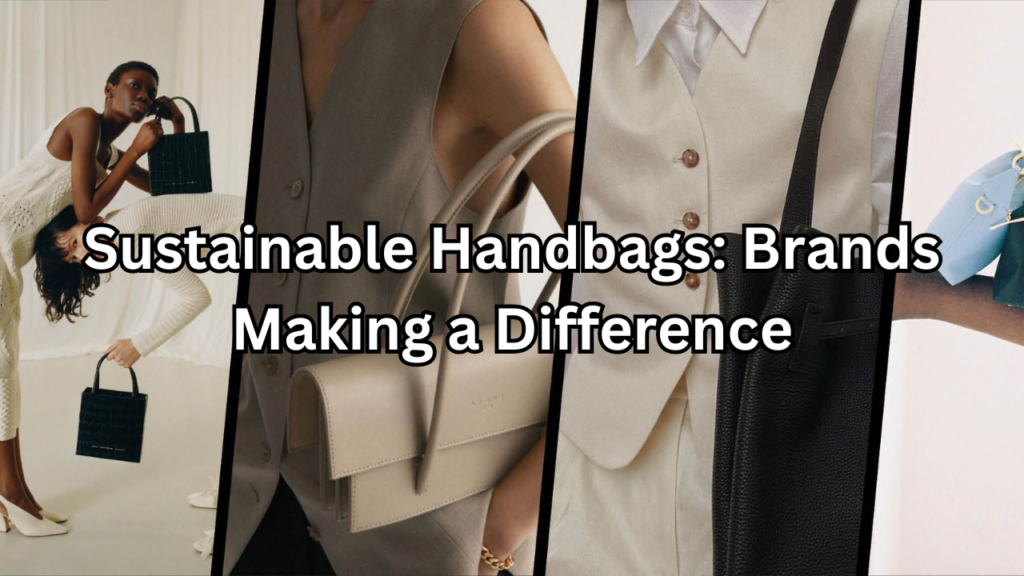
Table of Contents
In recent years, the fashion industry has witnessed a significant shift towards sustainability. Consumers are increasingly aware of the environmental impact of their purchases, and this includes the accessories they choose. Handbags, once seen as mere fashion statements, are now at the forefront of the sustainable fashion movement. This article explores the rise of sustainable handbags and highlights some of the leading brands making a positive impact on the environment.
Introduction: The Rise of Sustainable Handbags
Sustainability in fashion isn’t just a trend—it’s a movement that’s reshaping the industry. As awareness grows about the environmental and ethical implications of fast fashion, consumers are seeking out brands that prioritize sustainability. Handbags, as essential fashion accessories, are a key area where this shift is evident. But what exactly makes a handbag sustainable, and which brands are leading the way?
What Makes a Handbag Sustainable?
Materials: Choosing Eco-Friendly Fabrics
One of the primary factors in determining a handbag’s sustainability is the materials used. Sustainable handbags often feature eco-friendly fabrics such as:
- Recycled Materials: Many brands use recycled plastics or textiles, reducing waste and conserving resources.
- Organic Cotton: Grown without synthetic pesticides or fertilizers, organic cotton is a more environmentally friendly alternative.
- Vegan Leather: Made from non-animal sources, vegan leather reduces the need for animal hides and often has a lower environmental footprint.
- Upcycled Materials: Some brands repurpose old materials, giving them a new lease on life and reducing waste.
Ethical Production: Fair Labor Practices
Sustainability extends beyond materials to the production process. Ethical production practices ensure that workers are paid fair wages and work in safe conditions. Brands committed to sustainability often have transparent supply chains and adhere to fair labor standards.
Longevity: Quality Over Quantity
Sustainable handbags are designed to last. High-quality materials and craftsmanship ensure that these bags withstand the test of time, reducing the need for frequent replacements. Investing in a durable handbag not only supports sustainability but also offers long-term value.
Top Sustainable Handbag Brands
Stella McCartney
Stella McCartney is a pioneer in sustainable fashion. Her handbags are made from a variety of eco-friendly materials, including recycled polyester and vegan leather. McCartney’s commitment to ethical production and transparency has set a high standard for sustainable fashion.
Matt & Nat
Matt & Nat is known for its stylish vegan leather handbags. The brand uses recycled materials for linings and packaging, making their products both fashionable and eco-friendly. Their commitment to cruelty-free fashion resonates with many conscious consumers.
Freitag
Freitag specializes in upcycled handbags made from recycled truck tarps. Each bag is unique, featuring a distinctive design that reflects its history. Freitag’s approach to recycling and upcycling helps reduce waste and supports a circular economy.
Toms
Toms, initially famous for its shoes, has expanded into sustainable handbags. The brand uses recycled and organic materials in their products and adheres to ethical production practices. Toms also supports various social causes, making their handbags a choice with a purpose.
Cuyana
Cuyana promotes the “Lean Closet” philosophy, encouraging consumers to buy fewer, higher-quality items. Their handbags are crafted from sustainable materials and designed for longevity. Cuyana’s commitment to ethical production and minimal waste aligns with their sustainable values.
The Impact of Sustainable Handbags
Reducing Environmental Footprint
By choosing sustainable handbags, consumers contribute to reducing environmental impact. Eco-friendly materials and ethical production practices help conserve resources, reduce waste, and minimize pollution. Each purchase supports a more sustainable and responsible women fashion industry.
Promoting Ethical Consumerism
Sustainable handbags encourage ethical consumerism by highlighting the importance of fair labor practices and environmental stewardship. As more consumers make conscious choices, brands are motivated to adopt sustainable practices and contribute to a positive change in the industry.
Encouraging Innovation
The demand for sustainable handbags drives innovation in materials and production techniques. Brands are continuously exploring new ways to reduce their environmental footprint and improve their practices. This fosters a culture of innovation and sustainability within the fashion industry.
How to Choose a Sustainable Handbag
Research Brands and Materials
Equipments, Before Choose a handbag, research the brand’s sustainability practices and the materials used. Look for certifications and transparency in the supply chain. Understanding a brand’s commitment to sustainability helps make informed and responsible choices.
Invest in Quality
Opt for handbags that are well-made and designed to last. Quality craftsmanship and durable materials ensure that your investment will provide long-term value and reduce the need for replacements.
Consider Second-Hand Options
Exploring second-hand or vintage handbags is another way to support sustainability. By giving pre-owned bags a new life, you reduce waste and extend the lifecycle of fashion items.
Conclusion
Sustainable handbags represent a significant step towards a more eco-friendly and ethical fashion industry. By choosing brands that prioritize sustainable materials, ethical production, and longevity, consumers can make a positive impact on the environment. As the demand for sustainable fashion grows, more brands are likely to join the movement, offering a wider range of eco-friendly options. Embracing sustainable handbags is not just about fashion—it’s about making a difference.
